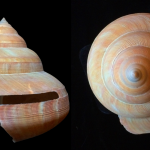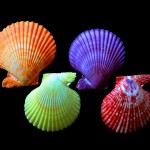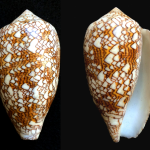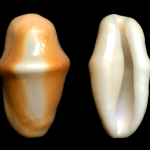This Open-House Special brings you inside the modern homes
of today’s most popular marine mollusks

Are you old enough to remember the show MTV Cribs, where a camera crew invades the home of a filthy-rich celebrity and takes annoyingly jumpy quick-shots of how awesomely decked-out and unnecessarily opulent their ‘crib’ is? Think about that approach, but with a Malacology Monday twist. Firing up a band-saw and with the warnings of my old school shop teacher “you’re gonna cut your thumb off” echoing in my head, our team will show you inside the ‘cribs’ of Malacology’s most interesting species.
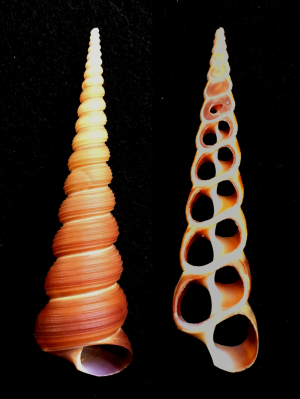
High-Rise House
First up, the aptly-named Screw Turritella (Turritella terebra: Turritellidae) with a tall, twisting spire. For gastropods, the shell is a home that offers protection to withdraw into when needed, and as the muscled-mass of the snail grows, so too must the shell. The opening – or aperture – of the shell is the front-door, and new shell material is excreted by the fleshy mantle around the edge of this opening. As the door gets bigger, the shell wraps around itself as a twisted, ever-widening tube. What you see in the cross section is a ‘crib’ that starts off tiny when the snail is just a wee one, and gets larger with age. While not ostentatious enough to make it on MTV, it’s still a cozy and versatile home.
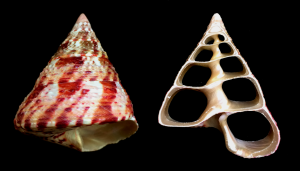
Cute as a Button
A peek inside the Commercial Topshell (Tectus niloticus, Trochidae) shows a low, tightly-twisting whorl, making the whole shell as a compact stout cone. The thick internal walls also provide strong structural support. Such a shape offers good architectural resistance from strong waves in shallow shores, and from shell-crunching fishes & crabs. From larger specimens, round shell disks are drilled to make buttons, hence the name Commercial Topshell, not that it is especially good at banking or international commerce. Since only a few buttons can be drilled from each shell, this species is heavily collected in the Indo-Pacific region where it lives, and since its meat is delicious, it has been fished-out in much of its range. Several countries are developing captive-breeding facilities to raise them commercially, and other programs employ captive hatcheries that release the young back in the wild to supplement the natural population. In many areas though, the main way to promote the population of the Commercial Topshell is to kill off their wild predators, like porcupine fishes, wrasse, bat rays, and crabs. Not such an ecologically sound approach especially since a single darned coconut can make more buttons than a dozen shells.
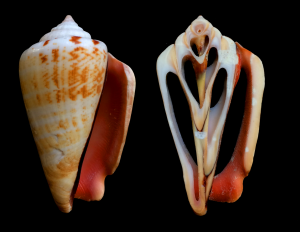
Home Security
Next we burst into the home of the Strawberry Conch (Strombus luhuanus: Strombidae), one of the smallest but most abundant conch species in the Indo-Pacific. Here we see the shell growing tightly around most of the body, leaving very little of the spire exposed. The aperture of the shell is very long and narrow, but since the resident snail has no internal hard parts, it can flatten its foot, head, and mantle to squeeze through that skinny opening. Such a thin front door is an adaptation against large predatory crabs, nature’s home-invasion robbers. In shells with a larger openings, crabs don’t politely knock, but hold the shell tight with one claw, and with the other, they jab it into the aperture and break the opening away. As the snail withdraws deeper into the shell, the crab just keeps turning and breaking the whorl of the shell until it reaches its prey. With the Strawberry Conch, their security system consists of this narrow opening that prevents a crab from inserting its claw in the first place, and the thickened lip around this opening provides extra strength to prevent the initial breakage of the aperture, keeping the snail safe inside

House of a Hundred Rooms
In this, our last visit through the dwellings of mollusks, we visit the palatial estate of the Chambered Nautilus (Nautilus pompilus; Nautilidae), with a grand array of ever diminishing luminous pearlescent back-rooms. As we saw during our tour through the rather Spartan dwellings of gastropods, the living chamber for the snail is a continuous tube that spirals around an axis, increasing in length and diameter as the animal grows. While the Chambered Nautilus develops in a somewhat similar way, the living chamber holds the mass of the tentacled landlord, but as the shell grows, the previous back-end of the living chamber is walled-off with a shiny layer of nacre. These rooms are connected by a spiral tube, the siphuncle (use that term in your next Scrabble match) that balances fluids, salts, and gasses, ultimately making each empty room an internal flotation device. Gastropods slowly drag their home along the sea floor like low-class campers, but the Chambered Nautilus uses blasts of water from its siphon to push the shell through the open water like a sporty, speedy, jet-powered blimp. In deeper water, the wall between each chamber strengthens the shell, preventing a disastrous implosion. Chambered Nautilus, I like your style.



